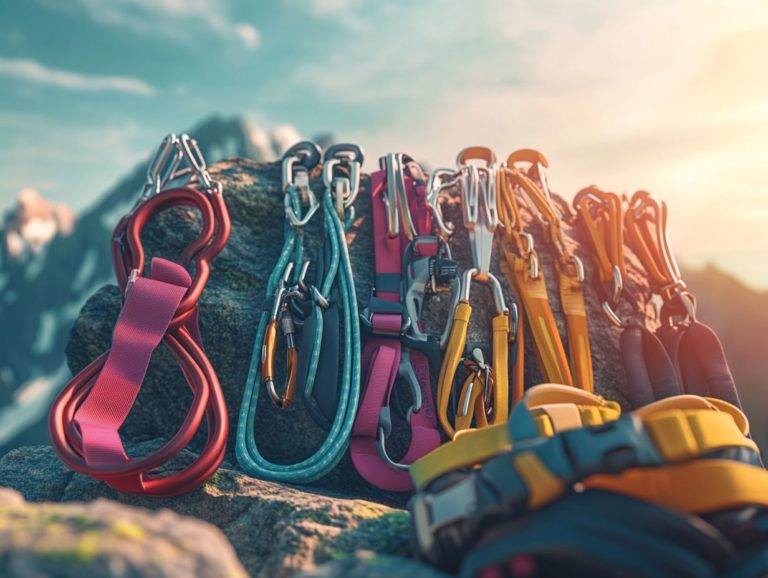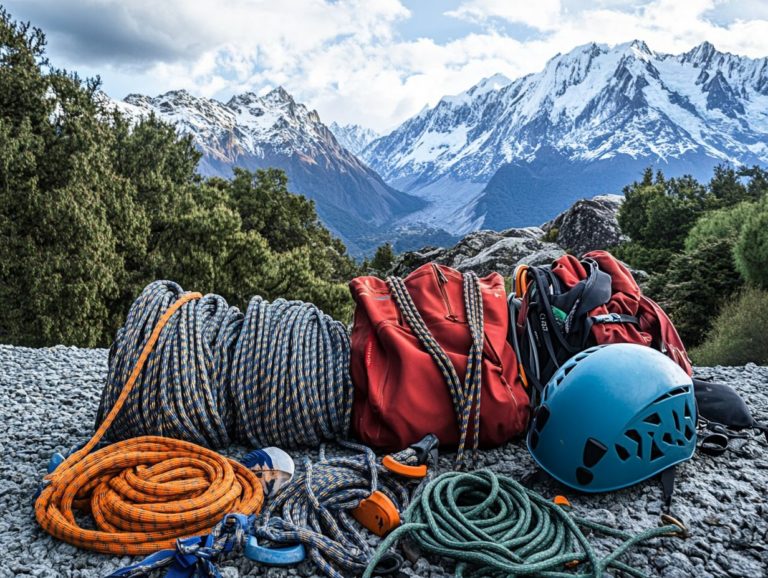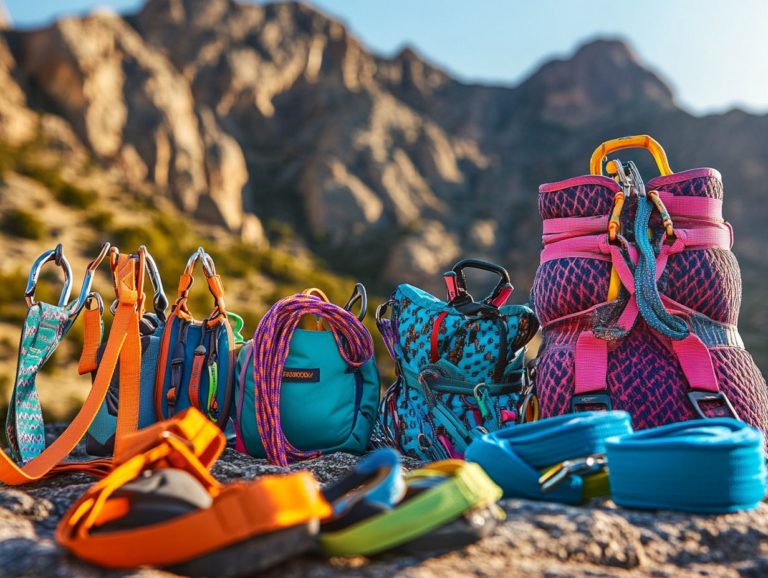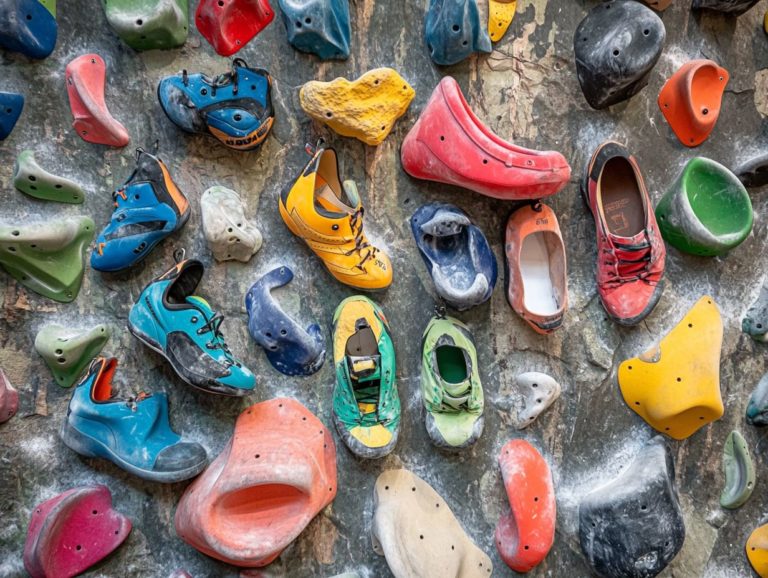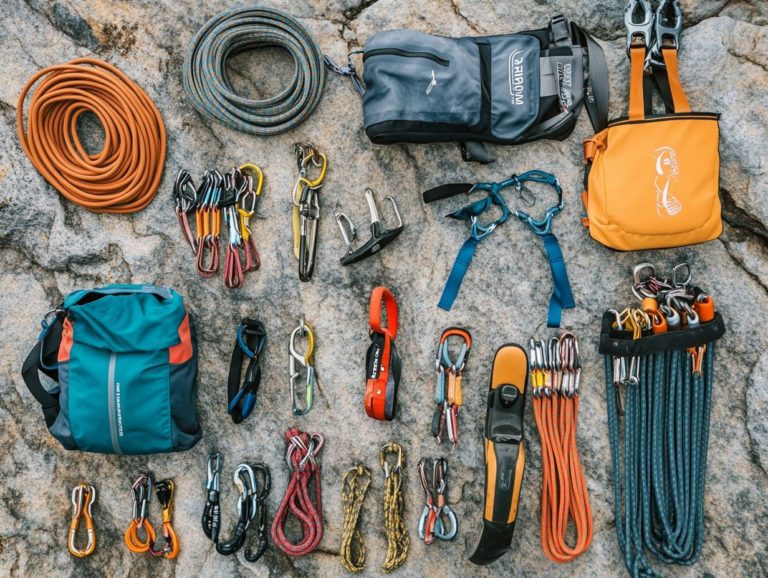A Guide to Climbing Gear Certifications
Are you ready to conquer the climbing world? Safety is key! When it comes to climbing, safety is very important, especially when using high-quality climbing gear.
Understanding climbing gear certifications like CE and UIAA can be the distinguishing factor between an exciting experience and a dangerous situation. This guide delves into the importance of these certifications, examining the various types UIAA, CE, and EN and offers insights on selecting gear that meets safety standards.
You will also find best practices for maintaining and renewing these vital certifications. Equip yourself with this knowledge about climbing safety standards to ensure that every ascent is just as safe as it is thrilling!
Contents
Key Takeaways:
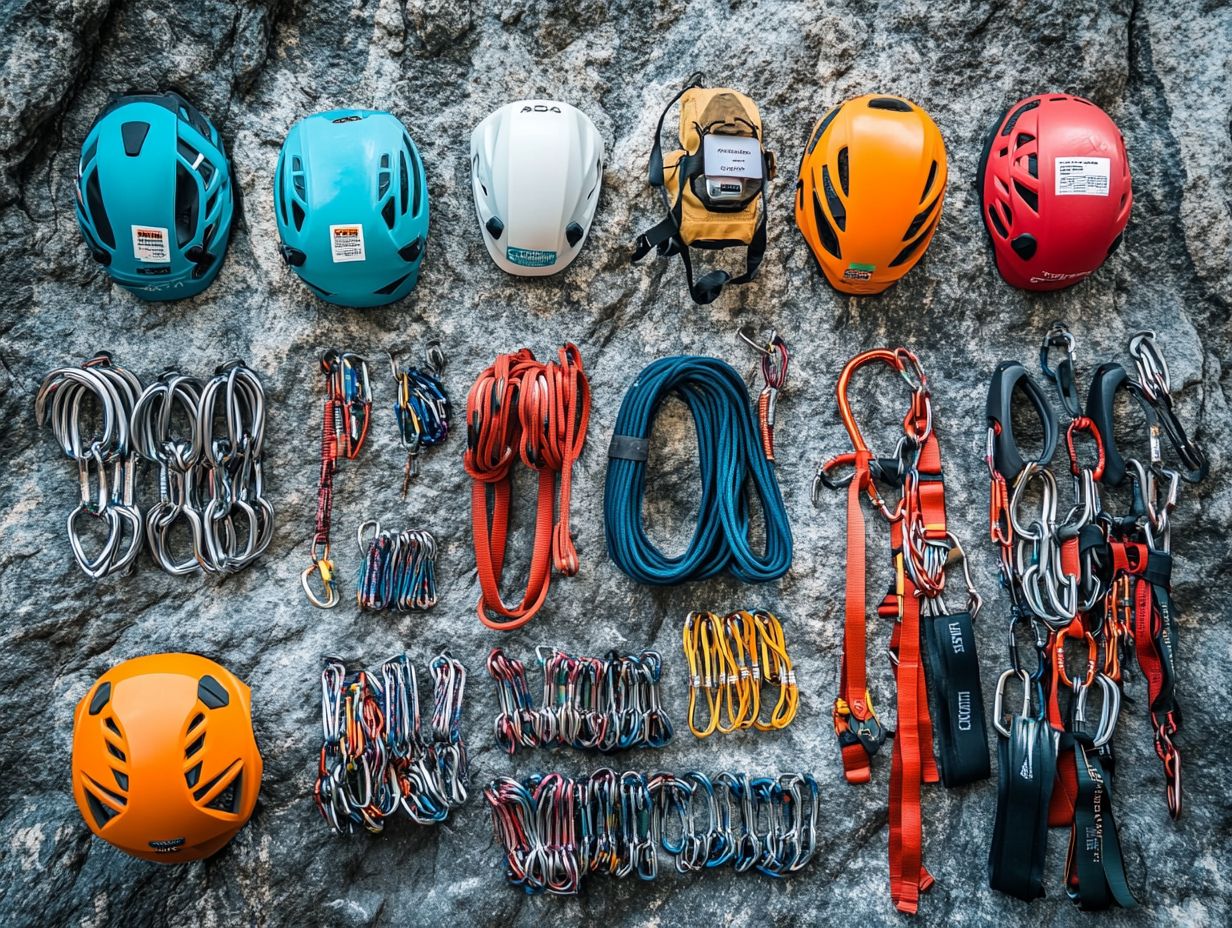
- Climbing gear certifications ensure safety and quality standards, making them crucial for any climbing activity.
- Types of certifications include UIAA, CE, and EN, each with its own specific standards and testing processes.
- When choosing climbing gear, consider factors such as certification, durability, compliance requirements, and suitability for your climbing style.
What are Climbing Gear Certifications?
Climbing gear certifications are essential for ensuring the safety and reliability of the equipment you rely on in the climbing industry. Certifications like CE and UIAA indicate that the gear has undergone rigorous testing processes and complies with established safety standards.
These certifications assure you that products such as climbing helmets and rope clamps have been evaluated by independent labs adhering to specific certification requirements. Knowing how these testing procedures work is important as it influences the design and manufacturing processes.
For manufacturers, adhering to safety standards, including ISO 9001, is not just a regulatory obligation; it’s a commitment to quality management that enhances their reputation in the market. Purchasing certified gear means selecting equipment that has proven its durability and safety through systematic testing.
This significantly reduces the risk of equipment failure when it matters most on the cliffs. In this way, both manufacturers and climbers thrive in a community rooted in high-quality safety protocols and gear testing, leading to a more enjoyable and secure climbing experience.
Why are Certifications Important for Climbing Gear?
Certifications for climbing gear are absolutely essential for ensuring both the safety and effectiveness of the equipment used within the climbing community. These certifications serve as a validation that products meet rigorous compliance standards, reinforcing the importance of gear certification.
Without them, you may unknowingly find yourself using non-certified gear, putting your safety at risk during climbs. The climbing industry fundamentally depends on these certifications to provide you with the assurance that your equipment whether it’s climbing helmets, rope clamps, or other personal protective equipment meets recognized safety standards.
Always check for certifications before your next climb to ensure your safety!
Ensuring Safety and Quality Standards
Ensuring the safety and quality of your climbing gear is complex and requires careful testing. This includes tests that measure how much weight gear can handle before breaking and strict adherence to recognized certification standards. Independent laboratories that perform gear testing are essential in this process. They evaluate gear like climbing helmets and other personal protective equipment to ensure they meet or exceed established safety benchmarks.
Quality assurance is crucial. It guarantees that your climbing equipment remains reliable, no matter the conditions you face during outdoor activities.
These labs use specific methods, including breaking strength tests, which check the maximum load a piece of gear can handle before it might fail. They also conduct usability evaluations to assess how intuitive and effective the gear is in real-world scenarios, especially concerning climbing safety.
Recognized certification standards, such as those set by the International Climbing and Mountaineering Federation (UIAA), the American National Standards Institute (ANSI), and the EN standard, enhance safety by establishing rigorous performance criteria. These standards require manufacturers to comply with strict guidelines, ultimately improving the safety and reliability of the climbing equipment you rely on.
Types of Climbing Gear Certifications
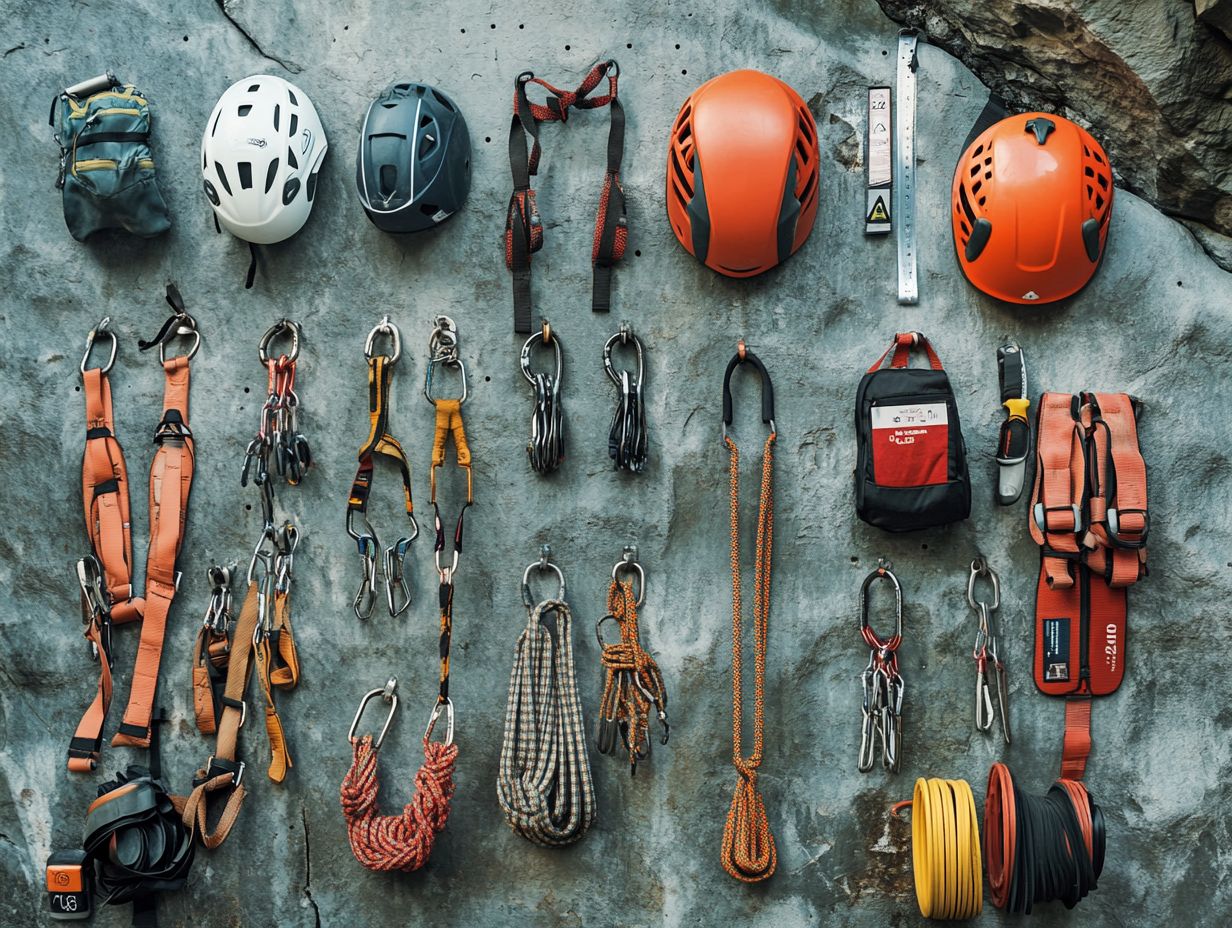
Several types of climbing gear certifications are crucial in the climbing industry. These include UIAA certification, CE certification, and EN certification. Each certification serves a distinct purpose, ensuring that climbing gear like helmets and harnesses meet established safety standards!
Understanding these certifications and their significance in the climbing community allows you to make informed choices about the gear you select for your climbing adventures, including referring to a climbing gear safety checklist for added assurance.
UIAA Certification
UIAA certification is one of the most respected benchmarks for climbing gear. It ensures that your equipment meets rigorous safety standards through a detailed testing process. The UIAA, or International Climbing and Mountaineering Federation, thoroughly evaluates gear like climbing helmets and rope clamps to ensure reliability and performance in extreme conditions.
To earn this certification, gear undergoes rigorous tests. For example, helmets are drop-tested, and ropes are evaluated for how much pulling force they can withstand, essential parts of the gear testing process. Each item is scrutinized against specific criteria tailored to its intended use. For instance, climbing harnesses must withstand a minimum load of 15 kN to be deemed compliant.
Renowned manufacturers such as Petzl, DMM, and Black Diamond produce a variety of UIAA-certified products. This highlights their unwavering commitment to climber safety and quality assurance. When you see this certification on your gear, it not only boosts your confidence but also fosters trust within the climbing community. It encourages you to invest in gear that meets these prestigious standards!
CE Certification
CE certification shows that the climbing equipment you re considering meets the strict safety standards set by the European Union and the ISO 9001 management system. This certification is crucial for various climbing gear like helmets and harnesses, serving as a symbol of quality and safety in the market!
Manufacturers must navigate a demanding process to obtain this certification. It involves comprehensive testing to ensure compliance with established directives and certification processes. These directives include critical requirements such as risk assessment, material quality, and helmet testing, ensuring that the equipment can withstand the rigorous nature of climbing activities.
The importance of CE certification extends beyond basic compliance. It is vital for determining a product s availability in the European market and its overall rating. As consumers become more aware of climbing safety standards, having CE certification increases a manufacturer s credibility, making their climbing gear more appealing to safety-conscious buyers!
EN Certification
EN certification includes a comprehensive set of standards that climbing gear must meet to ensure your safety and performance. Specific regulations, such as EN-12492 for climbing helmets and EN-1077 for ski helmets, ensure that your equipment is rigorously tested and certified for safety and usability in various climbing conditions. EN stands for European Norms, which outlines these essential standards.
This meticulous testing process involves thorough examinations of materials, durability, and functionality, giving you the confidence that the gear you rely on is trustworthy. By adhering to these EN standards, manufacturers not only showcase their dedication to quality but also enhance the overall safety of climbers like you.
Gear that meets these regulations is put through scenarios that mimic real-life climbing challenges, including breaking strength evaluations, ensuring reliable performance even in unexpected situations. Both beginners and seasoned climbers can feel secure knowing their equipment is expertly crafted to handle the demands of their adventures, as outlined in understanding climbing gear ratings, thereby fostering a culture of safety within the climbing community.
How to Choose Certified Climbing Gear
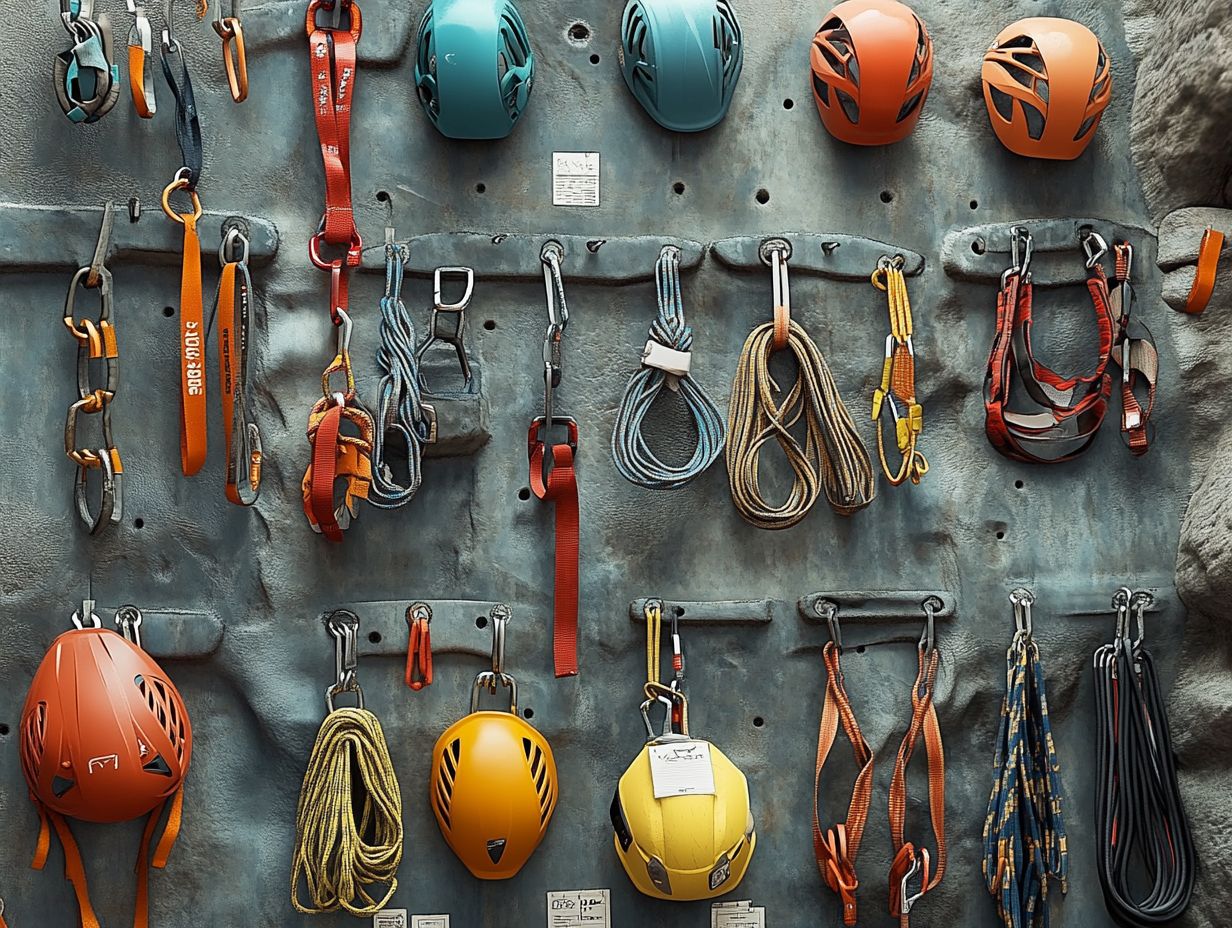
Selecting certified climbing gear is paramount for your safety during climbing activities, and it entails a thorough understanding of the various safety certifications, especially gear certification, relevant to outdoor equipment like safety ratings.
By assessing the manufacturers’ safety certifications and their adherence to established safety standards, you can make informed choices about the gear you use.
Factors to Consider
When selecting climbing gear, you must consider several factors, including the type of climbing equipment, its certification, and its availability in the market, to ensure both safety and performance. Think about the specific needs of your climbing endeavors, whether you re into mountaineering, sport climbing, or traditional climbing, and ensure you choose gear that meets the climbing safety standards.
It’s not just about knowing the gear; you also need to confirm that all equipment comes with proper certifications that adhere to technical standards. These certifications indicate that the gear has passed rigorous safety standards, which is crucial. For a deeper understanding, check out understanding climbing gear ratings explained. Using non-certified gear could pose significant risks during climbs, especially in high-pressure situations, leading to safety equipment failures.
Evaluating the reputation of gear retailers can give you valuable insights into the reliability of the gear they offer. Staying informed about current trends in climbing gear is also essential, as advancements in technology can boost performance and enhance safety, including innovations related to climbing helmets testing.
Thoroughly examining these factors helps you make choices that keep you and your climbing partners safe!
Maintaining and Renewing Certifications
Maintaining and renewing certifications for climbing gear is vital for ensuring your ongoing safety and compliance with established standards. Over time, gear can wear out, which makes it imperative for manufacturers and retailers to strictly follow certification processes that protect the well-being of the climbing community.
By prioritizing these practices, including regular gear testing, you contribute to a safer environment for all. Actively maintaining your gear is crucial don’t wait until it’s too late!
Proper Care and Re-certification Process
Taking care of your climbing gear is vital. It not only extends its lifespan but also ensures it meets safety standards during re-certification.
Regular checks for wear and tear, especially on helmets and harnesses, are crucial for maintaining your equipment’s integrity.
Start by establishing a consistent cleaning routine. Rinse off dirt and grime after each use, then allow your gear to air dry away from direct sunlight to prevent UV damage.
For storage, find a cool, dry place to keep your equipment. This helps prevent moisture build-up and the potential for mold growth.
Regular inspections are essential, ideally before and after climbing trips, to catch any issues early on.
The re-certification process involves sending your gear to trained experts who will perform thorough checks and make any necessary repairs, ensuring everything meets rigorous safety standards.
By prioritizing these practices, you enhance your performance and significantly contribute to overall climbing safety.
Frequently Asked Questions
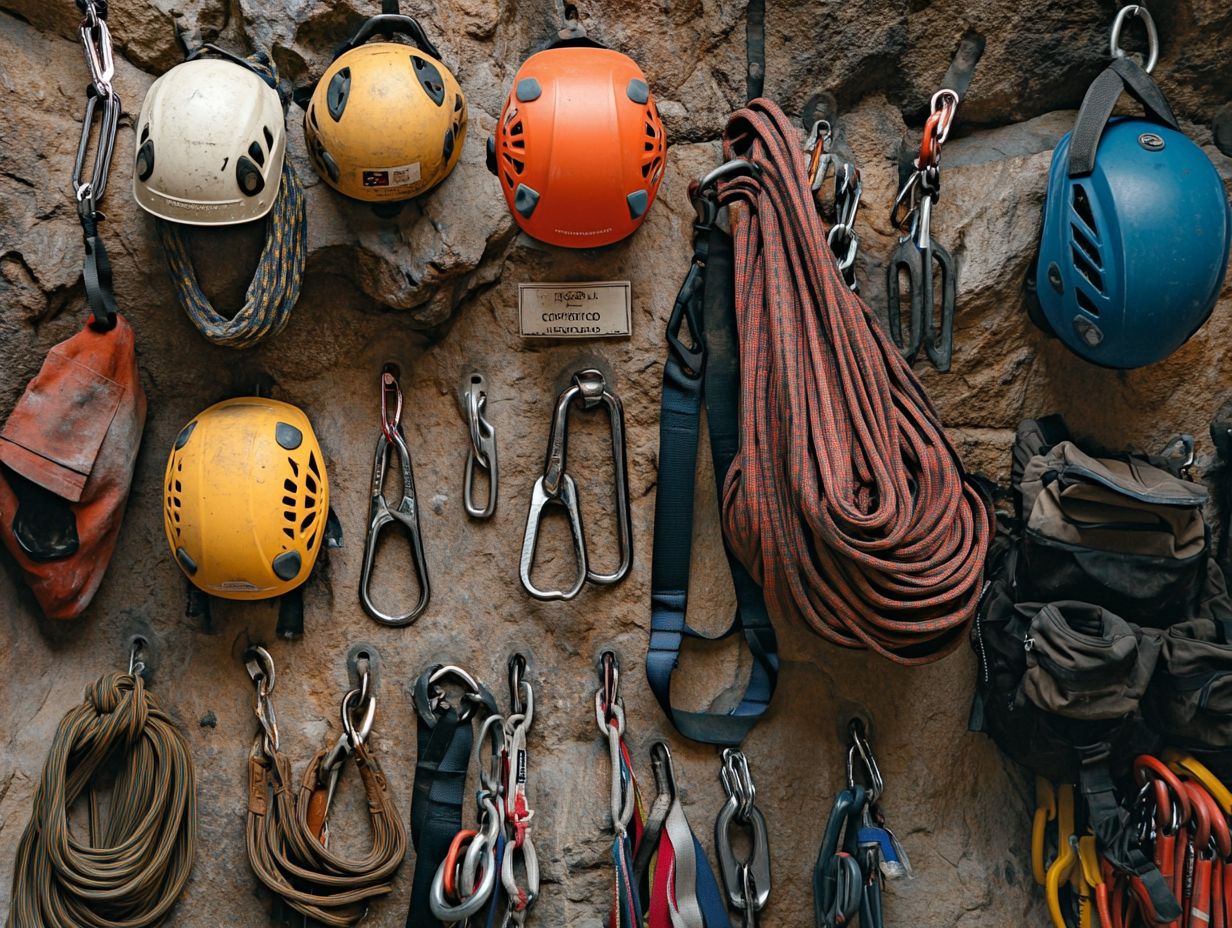
What are climbing gear certifications?
Climbing gear certifications are industry standards that ensure the safety and quality of climbing gear. Gear that meets specific criteria and passes rigorous testing receives these certifications.
Why are climbing gear certifications important?
Climbing gear certifications provide assurance that the gear you use has been thoroughly tested and is safe. They are recognized and trusted by climbers and climbing organizations worldwide.
What are some common climbing gear certifications?
Common climbing gear certifications include UIAA (Union Internationale des Associations d’Alpinisme), CE (European Conformity), and EN (European Norm). These certifications cover various types of climbing gear such as ropes, harnesses, and carabiners.
How can I check if my climbing gear is certified?
Make sure your climbing gear is certified by looking for the certification logo on the product or packaging. You can also check the manufacturer’s website for a list of certified products.
Do all climbing gear need to be certified?
No, not all climbing gear needs certification. However, using certified gear is highly recommended for your safety while climbing. Many climbing gyms and organizations also require it.
Are there any climbing gear certifications for used gear?
Yes, there are certifications for used climbing gear. The UIAA has a certification called “Certified Used Climbing Equipment,” ensuring that the gear has been properly inspected and is safe to use. Always check the certification of used gear before purchasing or using it.
Make sure to regularly check your gear and stay informed about climbing safety practices!

